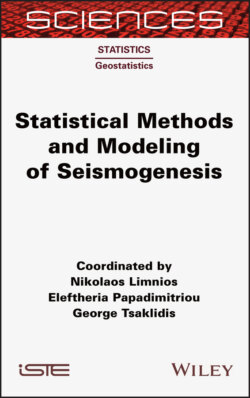Читать книгу Statistical Methods and Modeling of Seismogenesis - Eleftheria Papadimitriou - Страница 17
1.6. Transformation to equivalent dimensions
ОглавлениеMany studies into the physics of earthquake processes are based on investigations into the similarity of seismic events. The similarity of events means the similarity of their parameters. However, the parameters scale differently, which makes impossible comparisons of events in a multi-parameter space. To overcome this problem, Lasocki (2014) proposed a transformation of any seismic event continuous parameterization to the so-called equivalent dimension (ED). The ED of a parameter X is its CDF, Fx. All parameters transformed to EDs scale in the same way, have the uniform distribution in [0, 1], and every ED-transformed parameter space has the Euclidean metric. A rationale for the transformation to ED can be found in the referenced work.
The probabilistic models for earthquake parameters, Fx, are not known in general, but we can estimate Fx using the kernel estimation method (equations [1.6], [1.7], [1.10], [1.11] and [1.12], section 1.1). In this way, if a representative data sample is in hand, we can transform any parameterization of seismic events to ED. These can be source parameters like the occurrence time, the hypocentral coordinates but also magnitude, the components of moment tensor, the parameters of DC mechanism and the stress drop. These can be also derived parameters like the interevent time and the interevent distance, as long as they unequivocally link to seismic events. We can also link any non-seismic parameters with seismic events, and consider the seismic process in the space of such mixed, seismic and non-seismic parameters. In anthropogenic seismicity, for instance, such non-seismic parameters can be those describing the inducing technological process.
One-parameter data sample transformed to ED is uniformly distributed in [0, 1], which is demonstrated in Figure 1.7. However, its internal structure, e.g., when it is sorted to form a time series, can reveal interesting features. We can gain much more information when the structure and evolution of seismicity are investigated in a multidimensional ED parameter space. The transformation to ED allowed for studies in the spaces: three dimensional – {event occurrence time and geographical coordinates of epicenter} (Lasocki 2014), {hypocentral distance from injection well, three-dimensional rotation angle and deflection angle} (Orlecka-Sikora et al. 2019), eight dimensional – {hypocenter coordinates, plunge and trend angles of P and T axes of DC mechanism and polar and azimuthal angles of hypocenter in a local spherical system} (Lasocki and Orlecka-Sikora 2020) or four dimensional – {interevent time, interevent distance, hypocentral distance from the main shock and magnitude} (Lasocki 2014), to mention only a few. Figure 1.8, taken from (Lasocki 2014), shows an example of the use of transformation to ED. The transformation to equivalent dimensions is also available on the IS-EPOS Platform (tcs.ah-epos.eu, Orlecka-Sikora et al. 2020).
Figure 1.7. An example of the transformation to equivalent dimensions. The first column – raw data, and the second column–transformed data. The first raw – the polar angles of hypocenter in a local spherical system of coordinates, and the second raw – magnitude. For a color version of this figure, see www.iste.co.uk/limnios/statistical.zip
Figure 1.8. Changes in time of the total distance to centroid of the groups of 100 seismic events from the North Aegean area in Greece, preceding an Mw6.4 mainshock from July 26, 2001. The data was from a 100 km radius circle, centered at that mainshock location, and froma an 11.5-year period from January 1, 1981 to July 25, 2001. The events were represented by the interevent time, interevent distance, hypocentral distance from the main shock and magnitude, all transformed to equivalent dimensions. The black line represents the result for the actual time series of events, and the gray lines represent the results for 10 random permutations of the actual series. From about 3 years before the mainshock, the distance to the centroid exhibits a systematic decreasing trend. This result significantly differs from the results obtained from the permuted time series. This means that the mainshock was preceded by an increasing clustering of smaller events in the considered parameter space. Reprinted from Lasocki (2014, Figure 6a).
